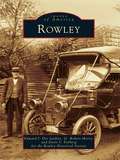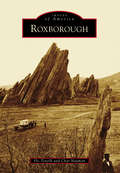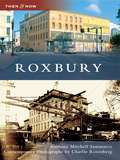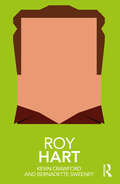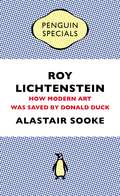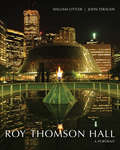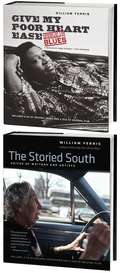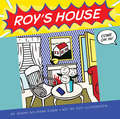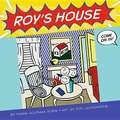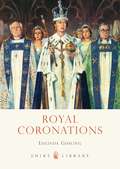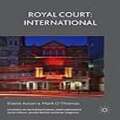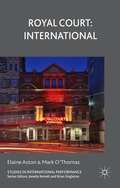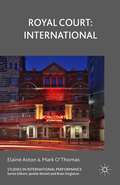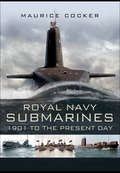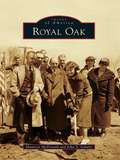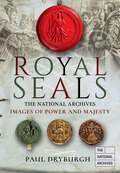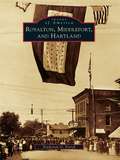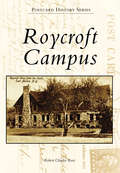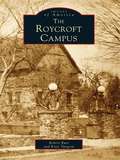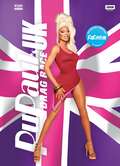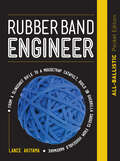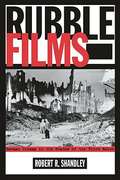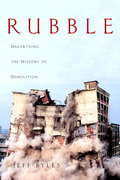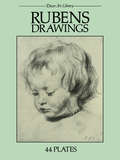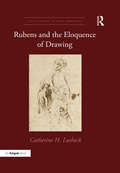- Table View
- List View
Rowley
by Doris V. Fyrberg Edward J. Des Jardins G. Robert MerryAs one of the earliest settlements in America, Rowley was founded by Rev. Ezekiel Rogers in 1639. Few towns as small in population have given more to the nation than Rowley, with so many firsts making up its history-from the great Puritan migration voyage across the sea that Rogers shared with the nation's first printing press to Lorenzo Bradstreet's invention of the Bradstreet Sleeper, which later evolved into the Pullman sleeping car.Rowley has much to offer: scenes of the village, and the historic town common, or the "Training Place," where Benedict Arnold's expedition to Quebec encamped in 1775, the picturesque Glen Mills area with its 1642 stone arch bridge, and the site of the first fulling mill in the colonies (1642-1643), which manufactured the first cloth made in the Western world. The book displays images of country stores, wagon peddlers, and early gristmills and sawmills. It also shows shoe manufacturing, boatbuilding (at its peak in 1900), farming, and salt marsh haying. It truly brings to life another era in American history.
Roxborough (Images of America)
by Char Nauman Flo TonelliPaleo-Indians hunted Ice Age mammoths and ancestral bison in what is now Roxborough, Colorado. In 1820, Stephen A. Long's expedition traveled west across the plains into America's western frontier and camped along the South Platte River where water rushed into the Platte Valley from Rocky Mountain peaks. They discovered an area described by their geologist as "a range of naked and almost perpendicular rocks . . . resembling a vast wall, parallel to the base of the mountain . . . the whole scenery truly picturesque and romantic." During the next 200 years, Roxborough has been home to Native Americans, mountain men, homesteaders, farmers, miners, dam builders, ranchers, railroad men, cowboys, and rocket scientists. Families live in sight of hogback formations, soaring red rocks, foothills, and mountains. Thousands arrive each year to hike trails in Roxborough State Park, Waterton Canyon, Colorado Trail, and Highline Canal. Roxborough's history, geologic wonders, and wilderness is a story of those whose eyes reached toward the stars.
Roxbury
by Anthony Mitchell Sammarco Charlie RosenbergRoxbury, annexed to Boston in 1867, has seen tremendous change as a result of land development and a shifting population. Today Roxbury is a "streetcar suburb" of the city and a thriving nexus of cultures, religions, and races.
Roy Hart (Routledge Performance Practitioners)
by Bernadette Sweeney Kevin CrawfordRoy Hart’s revolutionary work on the human voice through extended vocal technique and the Wolfsohn-Hart tradition has influenced several generations of practitioners. Hart’s outstanding contribution to vocal research, practice and performance stretched over 20 years until his untimely death in 1975, and his vocal training produced performers with extraordinary and highly expressive vocal ranges. He founded a theatre company, Roy Hart Theatre, that brought his ideas to realisation in ground-breaking works. His influence, through his own use of the voice for theatre and music and its embodiment in his company, was widespread, attracting the interest of directors such as Peter Brook, Jerzy Grotowski and Jean-Louis Barrault. This book combines: a detailed biography giving the social and artistic context of Hart’s work and that of the early Roy Hart Theatre an exploration of Hart’s own writings on his work, combined with a review of articles by his wife Dorothy Hart and in-depth interviews a stylistic analysis of his key works, including The Bacchae, and, L'Economiste and Biodrame, and their critical reception pathways into some of the practical exercises devised by close collaborators of Roy Hart and practitioners of the Roy Hart Theatre Tradition. As a first step towards critical understanding, and as an initial exploration before going on to further, primary research, Routledge Performance Practitioners offer unbeatable value for today’s student.
Roy Lichtenstein: How Modern Art Was Saved by Donald Duck (Penguin Specials)
by Alastair SookeA Penguin Special on Roy Lichtenstein by Alastair Sooke - read in 2 hours or less'Why, Brad darling, this painting is a masterpiece! My, soon you'll have all of New York clamoring for your work!' Roy Lichtenstein - architect of Pop art, connoisseur of the comic strip, master of irony and prophet of popular culture. From exhilarating images of ice-cool jet pilots in dog fights, to blue-haired Barbie dolls drowning in scenes of domestic heartache, Lichtenstein's instantly recognisable paintings, with their Ben-Day dots and witty one-liners, defined the art of a generation. But how did a jobbing, unassuming painter of the Fifties become a world-famous Pop artist whose work today sells for millions? What do his paintings really tell us? And what is his legacy?This book, by art critic and broadcaster Alastair Sooke, is a perfect introduction to the artist and his work. Spanning Lichtenstein's career, and explaining his unique style, it is a journey through the life of one of the twentieth century's greatest artists.Published in time for a major new retrospective of the work of Roy Lichtenstein.'Sooke is an immensely engaging character. He has none of the weighty self-regard that often afflicts art experts and critics; rather he approaches his subjects with a questioning, open, exploratory attitude' Sarah Vine, The Times'His shows are excellent - clever, lively, scholarly, but not too lecturey; he's very good at linking his painters with the world outside the studio, and at how these artists have affected the world today' Sam Wollaston reviewing 'Modern Masters', GuardianAlastair Sooke is deputy art critic of the Daily Telegraph. He has written and presented documentaries on television and radio for the BBC, including Modern Masters, an acclaimed BBC One series that chronicled modern art in the twentieth century. Since 2009 he has reported regularly for The Culture Show on BBC Two. He was educated at Christ Church, Oxford, and at the Courtauld Institute of Art, London.
Roy Thomson Hall: A Portrait
by William Littler John TeraudsA vibrant, richly illustrated commemorative book celebrating the first 30 years of Roy Thomson Hall, one of Canada’s most famous performance venues. Roy Thomson Hall: A Portrait traces the first 30 years of what was initially known as "New Massey Hall." Arthur Erickson’s iconic design quickly became a symbol of a vibrant city emerging on the world stage. Home to the Toronto Symphony Orchestra, the hall has welcomed a range of acclaimed artists and lecturers, film presentations, and corporate events. The authors provide a background to the musical history of Toronto and an intimate portrait of the hall’s changes over the years. At the centre of this story are the artists, audiences, volunteers, and staff who have enriched and enlivened the hall since its opening in 1982.
Roy Underhill's The Woodwright's Shop Classic Collection, Omnibus E-book
by Roy UnderhillFor more than twenty-five years, Roy Underhill has taught the techniques of traditional hand-tool woodworking. In six books and on his popular, long-running PBS series, The Woodwright's Shop, America's leading authority on old-time woodcraft has inspired millions to take up chisel and plane. This Omnibus Ebook brings together the first three books into a collection of Woodwright classics. Designed for both woodworking novices and for more seasoned woodworkers looking for enjoyable projects, these books feature step-by-step instructions, complete with easy-to-follow photographs and measured drawings. Included in this Omnibus Ebook edition: The Woodwright's ShopA Practical Guide to Traditional WoodcraftFeatures a guide to trees and tools as well as chapters on gluts and mauls, shaving horses, chairs, lathes, blacksmithing, log houses, and more.The Woodwright's CompanionExploring Traditional WoodcraftIncludes chapters on helves and handles, saws, the search for the whetstone quarry, hurdles, whimmy diddles, planes, window sashes, and pit sawing.The Woodwright's WorkbookFurther Explorations in Traditional WoodcraftWith step-by-step instructions for tool chests, workbenches, lathes, and historical reproductions of items for the home. Roy also explores building barns, boats, and even colonial fortresses.
Roy's House
by Susan Goldman Rubin Roy LichtensteinWelcome to Roy's house! Come on in and take a look around. There is a big sofa with room for lots of friends, three red fish swimming in a bowl, a yellow chair for reading, and, of course, Roy's studio, filled with paintbrushes. Susan Goldman Rubin pairs her simple narrative style with the energetic works of Roy Lichtenstein to create an early concept book that is also a fun and accessible introduction to one of the twentieth century's most iconic artists. Plus, this is the fixed format version, which looks almost identical to the print edition.
Roy's House
by Susan Goldman RubinWelcome to Roy's house! Come on in and take a look around. There is a big sofa with room for lots of friends, three red fish swimming in a bowl, a yellow chair for reading, and, of course, Roy's studio, filled with paintbrushes. Susan Goldman Rubin pairs her simple narrative style with the energetic works of Roy Lichtenstein to create an early concept book that is also a fun and accessible introduction to one of the twentieth century's most iconic artists.
Royal Coronations
by Lucinda GoslingIn 1953, Britain celebrated the coronation of Queen Elizabeth II, an event greeted at the time with widespread, nationwide enthusiasm. Sixty years on, the images and memories of the event still resonate, partly for their nostalgic appeal, but also as a reminder that while the monarchy of the modern age has had to move with the times, the affirming ritual of the coronation, with its pageantry, theatre and symbolism, is centuries old. This book takes a thematic look at the phenomenon of the coronation from its earliest origins and the meaning of the ceremonial rituals, to the precise behind-the-scenes organisation and the robes and jewels worn. It will also look at public responses to coronations over the years and how the magnificence of the event from the time of William the Conqueror gradually evolved and rose to new levels with the glorious global (and televised) celebration of 1953.
Royal Court: International
by Elaine Aston Mark O’thomasRoyal Court: International is the first full-length study of the Royal Court Theatre's International Department. It charts the engagement of the UK's premiere theatre for new writing with an internationalist agenda and takes readers inside the process developed by the Court for the workshop projects it has undertaken in different parts of the world since the late 1990s. Covering the theatre's unique programming of international plays and seasons, it highlights new writing from different parts of the globe, including France, Spain, Germany, Russia, Eastern Europe, Brazil, Cuba, Mexico, Columbia, Iran, the Near East, North Africa, Nigeria and India. First-hand accounts of the work appear in contributions from Stephen Daldry, Elyse Dodgson and Vicky Featherstone, and in interviews with Marcos Barbosa (Brazil), Anupama Chandrasekhar (India), Dominic Cooke, Sasha Dugdale, Marius von Mayenburg (Germany), Mark Ravenhill and Indhu Rubasingham.
Royal Court: International (Studies In International Performance)
by Elaine Aston Mark O’ThomasThe first ever full-length study of the Royal Court Theatre's International Department, covering the theatre's unique programming of international plays and seasons, its London-based residences for writers from overseas, and the legacies of workshops conducted in more than 30 countries.
Royal Court: International (Studies in International Performance)
by Mark O'Thomas E. AstonThe first ever full-length study of the Royal Court Theatre's International Department, covering the theatre's unique programming of international plays and seasons, its London-based residences for writers from overseas, and the legacies of workshops conducted in more than 30 countries.
Royal Navy Submarines: 1901 to the Present Day
by Maurice CockerThis is a must-buy for the Royal Navy and Submarine enthusiast, being a complete directory of RN submarines from the outset to the present day. There is a wealth of detail on each class. Every entry contains the specification, launch dates of individual boats, details of evolving construction and armament and other salient information in a compact form.The high quality of the drawings of the majority of classes adds to the value of this work which includes the very latest Astute submarines currently coming into service. This book is a complete directory of submarines and will be widely welcomed by all with an interest, professional or lay, in the subject.
Royal Oak
by John S. Schultz Maureen McdonaldStories describe Michigan's first governor, Lewis Cass, signing a treaty with the Chippewa in 1819 and resting nearby with companions under a swamp oak a few miles north of Detroit. Cass told the story of Prince Charles II, who took refuge in 1651 under a mighty oak tree after the Battle of Worcester and lived to be crowned king. Cass later designated the locality, including the southernmost townships in Oakland County, as Royal Oak. This sector became a village in 1891 and a city in 1921. Strong roots have helped the "City of Trees" maintain its viability through the years. Home to William Beaumont Hospital, assorted high-tech graphic and sound studios, and a world-class zoo, today Royal Oak draws people into its pedestrian-friendly downtown for an eclectic mix of bars, sidewalk cafés, boutiques, theaters, and upscale lofts.
Royal Seals: Images of Power and Majesty (Images Of The The National Archives Ser.)
by Paul Dryburgh“An intriguing look into the past through The National Archives . . . It offers a glimpse into the different seals of the monarchs, nobility, and clergy.” —Tudor BloggerRoyal Seals is an introduction to the seals of the kings and queens of England, Scotland and latterly the United Kingdom, as well as the Church and nobility.Ranging from Medieval times to modern day, it uses images of impressive wax seals held at The National Archives to show the historical importance of these beautiful works of art.Included are features on the great seals of famous monarchs like Richard III, Henry VIII, Elizabeth I and twentieth-century monarchs, as well as insights on the role of seals in treaties and foreign policy.With ecclesiastical seals and those of the nobility and lower orders included, this is a comprehensive and lavishly illustrated guide.“It is actually very fascinating as the book looks at the different types of seal used by various monarchs and why the seal came into being. We read about some of the most notable monarchs such as Charles II, George IV, James I, Henry VIII and more. But what has to be the best part of this book produced in conjunction with The National Archives, is the high quality of the pictures, certainly fantastic and really do show off the book at its best.” —UK Historian“The book should interest readers of Medieval Archaeology, providing a good introduction to the subject through what is undoubtedly an amazing national collection.” —Medieval Archaeology
Royalton, Middleport, and Hartland: Through Time (Images of America)
by Mayor Julia Maedl Frederick G. FierchNestled in the eastern end of Niagara County are the townships of Royalton and Hartland. The village of Middleport lies mostly within the town of Royalton, with a small part in the town of Hartland. When the Erie Canal was built through Royalton and opened in 1824, it connected the interior of the United States with the Atlantic Ocean, and the entire area was forever changed by the canal. The area earned a reputation as an excellent fruit-farming region and orchards appeared, along with the chemical-spraying industry. Royalton, Hartland, and especially Middleport became extraordinarily important in these two industries, and the canal was the focal point. The Erie Canal continued to be a major shipping factor for the region until the barges discontinued use in the 1950s.
Roycroft Campus (Postcard History)
by Robert Charles RustThe history of the American Arts and Crafts movement is embodied in the Roycroft community. Founded by Elbert Green Hubbard, the Roycroft is more than just a National Historic Landmark in the charming village of East Aurora, New York. Roycroft's artisans and craftspersons ?ourished from 1898 to 1938, producing some of America's best and most important crafts, furniture, and books. This visual history through postcards and motto cards produced by the Roycrofters' presses shares the story and philosophy of their movement. Here, the 1898 postcards featuring "the Characters of the place" and the years of the "Roycroft Renaissance" show the growth and continuity.
Roycroft Campus, The
by Kitty Turgeon Robert RustElbert Hubbard and his Roycrofters were one of the most influential aspects of the American Arts & Crafts Movement. Hubbard founded the Roycroft Press in 1895, and by the turn of the century, the varied and eclectic group of artisans and celebrities who flocked here had transformed the small town of East Aurora, New York, into a world-renowned utopian crafts community. In this volume of over 200 images, you will experience the Roycroft campus as never before, viewing rare images of the people who made the Roycroft dream a reality. Discover their many contributions to the area's progress and see examples of their creations, from handmade books to intricate metal works and rare furniture. All of the 14 buildings that now comprise the National Historic Landmark Roycroft Campus have been documented inoriginal photographs and from postcards, promotions, and their own publications; many appear within these pages for the first time in book form. The Roycroft continues to be one of the most prominent areas of international Arts & Crafts Revival. After an extensive restoration following the community's centennial in 1995, the Roycroft Inn has reopened, and the area has once again become an artistic and, now, historic mecca for visitors from all over the world.
RuPaul’s Drag Race UK: The Official Companion
by Christian GuiltenaneRuPaul's Drag Race UK returns to our screens with a stellar cast of incredible Queens ready to slay the runway.Discover the secrets of the Werk Room and get all the gossip backstage in exclusive interviews with the Queens. Take on mini challenges, learn the secret to a killer Snatch Game performance, and re-live the most iconic moments of RuPaul's Drag Race UK so far with stories from the Queens of the show. With special features, play-along games, secrets and trivia, this is your perfect companion to the Drag Race extravaganza! Remember kids, reading is fundamental!
Rubber Band Engineer
by Lance AkiyamaRubber Band Engineer: All-Ballistic Pocket Edition is a fun-filled book of backyard projects that's perfect for gifting. Shooting far, flying high, and delivering way more exciting results than expected are the goals of the gadgets in Rubber Band Engineer: All-Ballistic Pocket Edition. Discover unexpected ways to turn common materials into crafty contraptions that range from surprisingly simple to curiously complex. Through vivid color photos, you'll be guided to create slingshot rockets, unique catapults, improvised darts, and a clever crossbow. Whether you build one or all 10 of these designs, you'll feel like an ingenious engineer when you're through. Best of all, you don't need to be an experienced tinkerer to make any of the projects! All you need are household tools and materials, such as paper clips, pencils, paint stirrers, and ice pop sticks.Oh, and rubber bands. Lots of rubber bands.Grab your glue gun, pull out your pliers, track down your tape, and get started on the challenging, fun, and rewarding journey toward becoming a rubber band engineer.
Rubble Films: German Cinema in the Shadow of the Third Reich
by Robert R. ShandleyAt the end of World War II, Germany was a broken nation. Split in two and occupied by the victorious Allies, it would have to be rebuilt, literally, from the rubble of its own defeat. Volumes of books have been published chronicling its structural and economic rebirth; this unique study reveals how Germany rebuilt itself culturally. Rubble Films is a close look at German cinema in the immediate postwar era, and a careful examination of its relationship to Allied occupation. Shandley reveals how German film borrowed -- both literally and figuratively -- from its Nazi past, and how the occupied powers (specifically the US) used its position as victor to open Europe to Hollywood movie products and aesthetics. Incorporating a careful reading of several important postwar films, Shandley also discusses how the German studio system operated immediately after the war, in the east and the west, giving special focus on DEFA, the east German studio that rose during Soviet occupation. Pathbreaking in its research, Rubble Films sheds new light on a significant moment of German cultural rebirth, and adds a new dimension to the study of the history of film.
Rubble: Unearthing the History of Demolition
by Jeff BylesA history of key episodes in the world of demolition. Stretching over more than 500 years of razing and toppling, it looks back to London's Great Fire of 1666, where wreckers blew houses apart with gunpowder to halt the furious blaze, and spotlights the advent of dynamite that would later fuel epochal feats of unbuilding. It also surveys the invention of the wrecking ball, the stirring ruin of N.Y.'s old Pennsylvania Station; and the ever busy bulldozers in places as diverse as Detroit, Berlin, and the British countryside. The book makes first-hand forays to implosion sites and digs into wrecking's historical record. Explores what happens when buildings fall, when monuments topple into memory, and when destructive creativity tears down to build again.
Rubens Drawings: 44 Plates
by Peter Paul RubensPeter Paul Rubens' gifts as an artist were as comprehensive as they were supreme. A prolific painter of illimitable resource and invention, he was a master of intellect and emotion, figure and form, color and sweep. In all his artistic endeavors, he proved himself the true heir of Renaissance art of both the North and the South, inspired by -- and assimilating -- the best of both. Yet he was very much a man of his time and in retrospect the most powerful, exuberant, and sensuous exponent of the Baroque style in painting.His extraordinary drawings reflect all of these qualities but color, and in them the viewer can clearly perceive -- and enjoy at leisure -- the awesome range of Rubens' genius. In this superb collection of 44 of his choicest drawings are deeply probing portraits and powerful religious and mythical scenes. His self-portrait, full of opulent and flowing forms, reaches out to us with a startling, penetrating gaze. His individual portraits of a young girl and of George Villiers, Duke of Buckingham, reveal in both instances a touching sensitivity mixed with aristocratic self-possession.Here, too, are two scenes of poignant tenderness suspended in a majestic flow of movement: one depicting the entombment of Christ; the other, Venus lamenting Adonis. The exciting "The Death of Hippolytus" and "A Battle of Greeks and Amazons" reveal Rubens' total command of complex patterns of action and movement. These and over three dozen other works offer limitless pleasure and stimulation to all who prize and wish to study the art of drawing at its most inspired. Meticulously reproduced on fine-quality paper, and offered at a very reasonable price, this beautiful book belongs with others in your collection, reflecting the greatest achievements in Western art.
Rubens and the Eloquence of Drawing (Visual Culture in Early Modernity)
by Catherine H. LusheckRubens and the Eloquence of Drawing re-examines the early graphic practice of the preeminent northern Baroque painter Peter Paul Rubens (Flemish, 1577–1640) in light of early modern traditions of eloquence, particularly as promoted in the late sixteenth- and early seventeenth-century Flemish, Neostoic circles of philologist, Justus Lipsius (1547–1606). Focusing on the roles that rhetorical and pedagogical considerations played in the artist’s approach to disegno during and following his formative Roman period (1600–08), this volume highlights Rubens’s high ambitions for the intimate medium of drawing as a primary site for generating meaningful and original ideas for his larger artistic enterprise. As in the Lipsian realm of writing personal letters – the humanist activity then described as a cognate activity to the practice of drawing – a Senecan approach to eclecticism, a commitment to emulation, and an Aristotelian concern for joining form to content all played important roles. Two chapter-long studies of individual drawings serve to demonstrate the relevance of these interdisciplinary rhetorical concerns to Rubens’s early practice of drawing. Focusing on Rubens’s Medea Fleeing with Her Dead Children (Los Angeles, Getty Museum), and Kneeling Man (Rotterdam, Museum Boijmans Van Beuningen), these close-looking case studies demonstrate Rubens’s commitments to creating new models of eloquent drawing and to highlighting his own status as an inimitable maker. Demonstrating the force and quality of Rubens’s intellect in the medium then most associated with the closest ideas of the artist, such designs were arguably created as more robust pedagogical and preparatory models that could help strengthen art itself for a new and often troubled age.
